

2016 WINNER
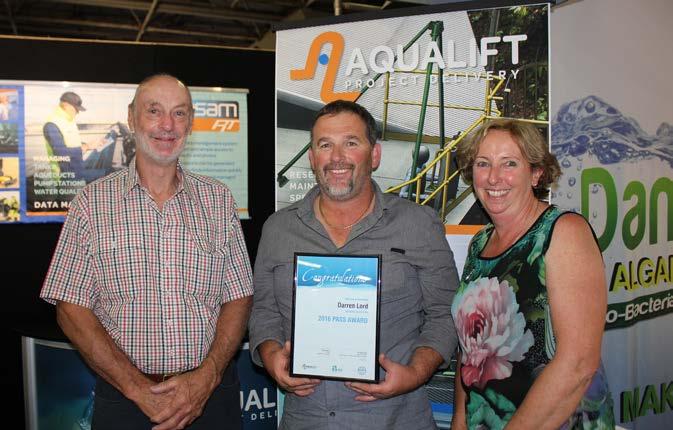

An award providing opportunity for water industry operational staff to share their in the field innovations & fixes to problems so that others in the water industry can benefit.

2016 PASS Award Winner Darren Lord from TasWater with David Barry (L) and Jillian Busch (R) from Aqualift Project Delivery
Equipment
2016 WINNER

Sodium hypochlorite transfer stand
Darren Lord, Technical Officer/ Senior Operator, TasWater
THE PROBLEM
The Safety of our workers when transferring Sodium Hypochlorite from 15L containers to a 200L chemical dosing tank at some of our dosing stations.
How did the problem impact you or your work situation?
Manual and chemical handling. Having chemical spills and or injury lifting 15L containers chest height and holding at this height whilst container empties.
How long had the problem been occurring?
Approximately 3 years since we changed from 200L drums which posed other issues thus why changing to the 15L containers.

THE SOLUTION
Lying in bed one night thinking about a comment about purchasing a drum pump to transfer the Sodium Hypochlorite thinking that you still need to hang onto both the pump and the hose that this could get ugly. So come up with the idea and sketched it down then I got the okay to get one made to trial.
Who helped work on the solution?
I ran the idea past a few of my fellow work mates to get their opinion.
Describe the solution.
We made a stand which holds a drum pump that slides up and down into the 15L containers, transferring the Sodium Hypochlorite through a hose fixed to the chemical tank. This means there is no need to hold any part of the drum pump, hose or container whilst transferring and there is no handling of opened containers of Sodium Hypochlorite.
How has it helped you at work?
We have found that there is less chance of an accident occurring, which means less chance of having to sit there and filling all the paperwork out and going through the internal interviews.
Suggest improvements.
This is a KISS idea (Keep it simple stupid). If anything we could improve the slide mechanism.
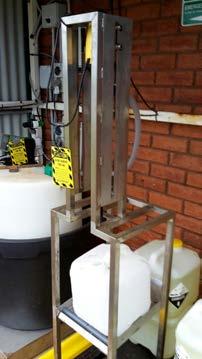
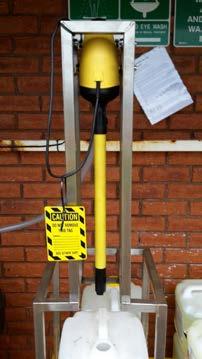
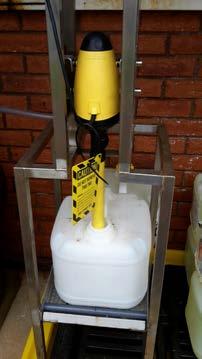

Equipment lifting & lowering device
Bevan Hudson, Technical Support Officer, BW Water Solutions
THE PROBLEM
Lifting tools, chlorine containers and small equipment up onto tank roof areas can be difficult without a device to reduce friction and maintain control of the rope.
How did the problem impact you or your work situation?
When lifting gear up, it was just hanging the rope over the handrail and hauling up. The heavier the object, the more friction on the rope. Some objects such as 20L chlorine containers can be difficult to lift over the edge of the handrails, when you cannot ‘lock off’ the rope.
How long had the problem been occurring?
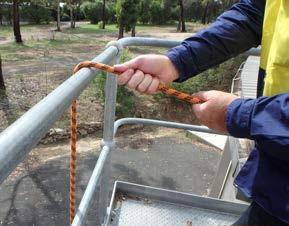
The problem appears to be common across the water industry, and there have been no easy solutions that I have seen to date.
THE SOLUTION
Sailing boats have sheet winch capstans fitted to control the ropes, so I decided to use one, clamped onto the handrails to make the lifting operation easier.
Who helped work on the solution?
I tried a few variations around the workshop and used a pipe vice as the anchoring component. A pulley on the end reduced the friction as the rope passed over the edge.
Describe the solution.
We needed a device that was portable and easy to install on any elevated structure handrail, where goods had to be lifted up to the roof area. A pipe clamp, yacht capstan and pulley were mounted onto a length of aluminium square tube. The unit clamps onto round or square handrails and then has a safety rope clipped around the rail as a backup. When hauling up, you can stand directly behind the unit, or off to one side if the working area is limited. When lowering things down to the ground, you simply take a turn around the capstan, so that it acts as a brake (it can only rotate in one direction). A few more wraps of the rope around the capstan locks off the rope and allows you to take your hands off it completely, when manoeuvring an object up and over the edge.
How has it helped you at work?
It has made the everyday job far easier and quicker. It also saves on ‘back pain’ and pulled muscles. More particularly you have better control over the positioning and hauling up on a rope to prevent accidental loss of control or pinched fingers.
The component materials, such as the capstan and pipe vice are quite expensive for good quality outcomes, but using cheaper components would risk failure at some time, when least expected.
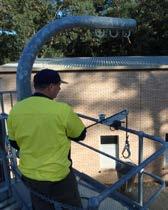
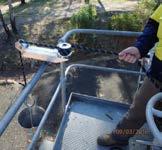

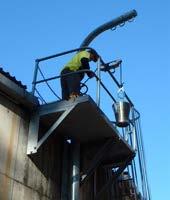
Lifting application
Device in locked off position
Lowering with rope wrapped as a brake
Lifting application
Tow bar extension
Kenneth Welsh, Water Operator, Nambucca Shire Council
THE PROBLEM
The new off river storage dam at Bowraville has a long, shallow angled boat ramp and we have to immerse the front and back wheels and brakes of the towing vehicle into the water to launch the boat effectively.
How did the problem impact you or your work situation?
The boat is launched on a regular basis to maintain and service the dam. The immersion of the front and back wheels and brakes of the tow vehicle would have created a maintenance problem.
How long had the problem been occurring?
For six months.
THE SOLUTION
During the discussion with water crew, the Water Attendant Liam Williams mentioned that this is the same problem with launching fishing boats in saltwater and he had seen a similar fabrication.
Who helped work on the solution?
Our Mechanical Workshop assisted in design and fabrication and the mechanic, Craig Mills built the adaptor.
Describe the solution.
By fabricating a temporary extension section to the trailer tow hitch we can effectively launch the boat while the tow vehicle wheels remain dry. This hitch is folded back and stored against the trailer frame for normal towing situations and when parking the boat within the storage shed.
How has it helped you at work?
By keeping the tow vehicle out of the water it has removed the possibility of contaminants going into our water supply and reducing maintenance costs on the tow vehicle.
Suggest improvements.
An improved swivelling arrangement on the extension mounting bracket would allow for easier disconnection of the extension ball from the main tow hitch. It is always worthwhile discussing problems with your crew, as this shows an easy solution can often be found.
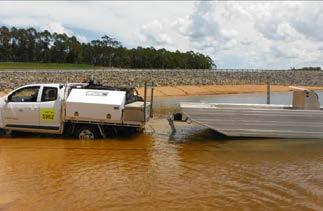
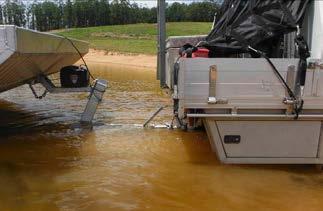
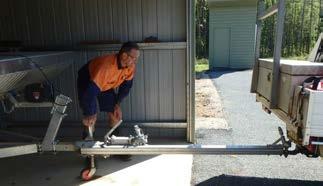
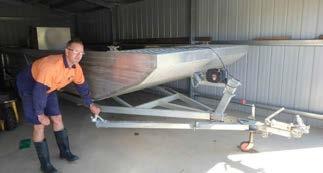
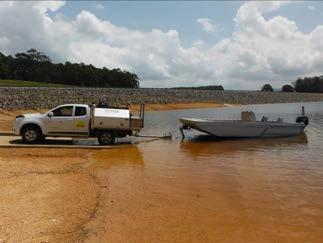
Winneke filters media loss reduction PLC changes
Mark Chilinski, Water Supply Operator, Melbourne Water
THE PROBLEM
The first step of the filter backwash process is to air scour for three minutes followed by six minutes of wash water. On the completion of the air scour process, there is a pause before the wash water pumps are started up. The remaining air is trapped in the plenum chamber and laterals and is then forced out by the washwater being introduced. The air is pressurised and compressed which creates high velocity air that disrupts the gravel and sand layers leading to sand being washed over the gullet or filling the space left behind and filling the nozzles and laterals.
How did the problem impact you or your work situation?
This problem results in filter media being lost both via the filter nozzles into the filter plenum chamber and over the backwash gullet and into the washwater system. This results in increased maintenance and cleaning of the filter plenums and wash water system. It also leads to compromised filtration and inefficient filter backwash
How long had the problem been occurring?
The plant has had an inherent problem with excess air in the plenum chamber after backwash for several years. Several improvement options have been implemented in the past with limited success and there was still evidence of this issue observed by operators during routine filter backwashes
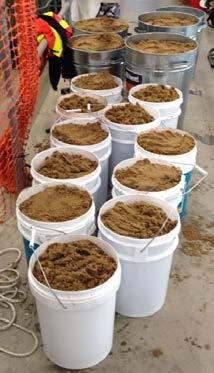
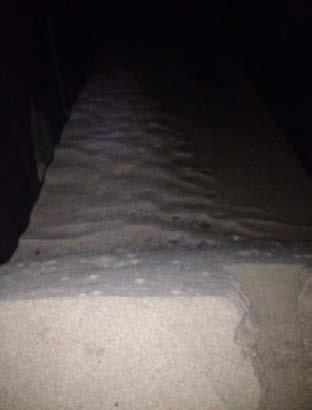
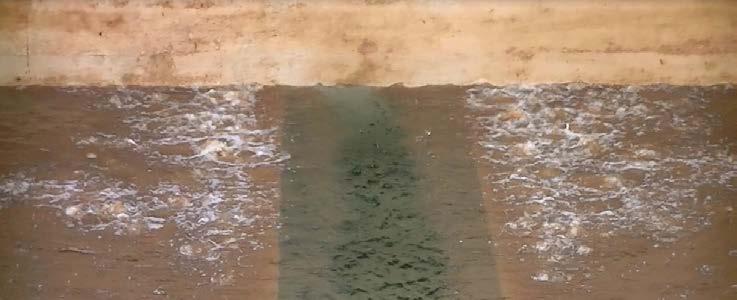
THE SOLUTION
This issue was highlighted during our recent filter inspection program where a backwash improvement project was initiated to address several improvement options. I had trialled this solution during several backwashes which appeared to show a marked reduction in boiling during the washwater cycle of the backwash.
Who helped work on the solution?
Further trials were conducted with the aid of our process support team with video evidence collected. We also monitored the sand volume presenting in the washwater system and noted a significant reduction. Each of the filter plenums were also cleaned out with the aim to quantify the sand reduction during the next scheduled inspections.
Describe the solution.
To reduce the effect of this pressurised air, it was proposed to relieve it prior to the introduction of the wash water. Prior to this change, the air relief valves only relieve the air in the manifold as the air inlet valves remain shut. This change will mean that the air inlet valves remain open during the air relief process and the trapped air within the filters will be able to equilibrate to atmospheric pressure before washwater is introduced. This reduced the amount of pressurised air being pushed through the filter during the washwater process and reduced the amount of disturbance to the media and the amount of media loss.
Since the introduction of this pause timer with air relief the grit system on the backwash handling system did not fill a 1 m3 skip bin for at least three to four months. Previously, this bin was emptied on approximately a fortnightly basis.
How has it helped you at work?
Implementing this solution will ultimately improve filter backwash performance and filtrate quality and also reduce maintenance costs associated with sand removal from the filter plenum’s and washwater system.
Suggest improvements.
To further improve air relief during the washwater cycle it has been proposed to install a fixed, automated vent valve in the backwash air line to relieve air constantly during the washwater cycle. As this is a significant project cost we have agreed to install one trial valve and if this proves successful then this solution may be implemented across all 16 filters.
The filter inspection course run by Peter Mosse has certainly increased the team’s awareness of filter performance issues and helped us facilitate a thorough filter inspection program during which, many of these issues were identified.
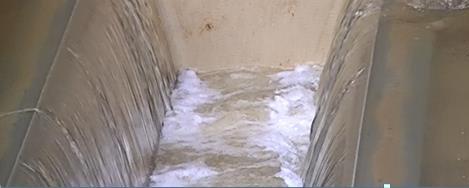
Use of battery operated valve opener for sedimentation inlets
Jamie Sim, Neil Parker, David Lowe and Chris Copley, Water Treatment Process Technicians, Allwater
THE PROBLEM
Opening the sedimentation inlet penstock valves requires at least 60 full turns to open each valve, with 5 valves for each sedimentation tank. The plant has 4 sedimentation tanks, and these are in 2 pairs of 2 tanks, with a total of 20 inlet penstock valves. Opening and closing each valve requires 2 people due to the number of turns and the tightness of the valves as they are operated usually about 4 times a year on average. Operating the valves (with the excessive tightness of the valves) required a considerable amount of manual labour and the risk for potential injury was very high.
How did the problem impact you or your work situation?
The valve operation diverted personnel from other duties. The length of time required to open and close valves was long, especially if for operational reasons it was necessary to close one pair of sedimentation tanks, open the other pair of tanks, and then open the first pair of sedimentation tanks again. Seasonal factors, such as taking off line a pair of sedimentation tanks for cleaning and maintenance of plant and equipment within the sedimentation tanks, such as flocculators, increased the number of valve operations.
How long had the problem been occurring?
The problem has been present since the plant has been in operation (which was back in 1988) and requires a considerable amount of manual labour to carry out each valve operation.
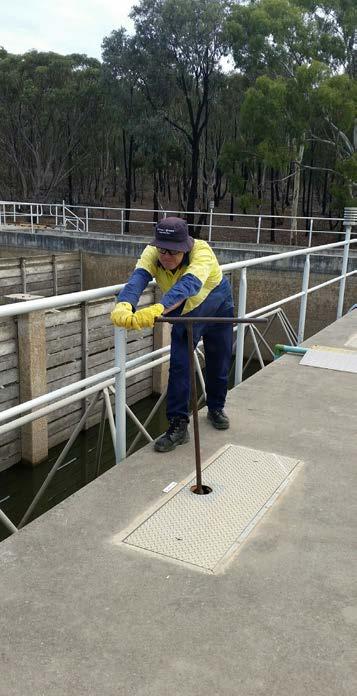
The problem - 60 full turns each valve
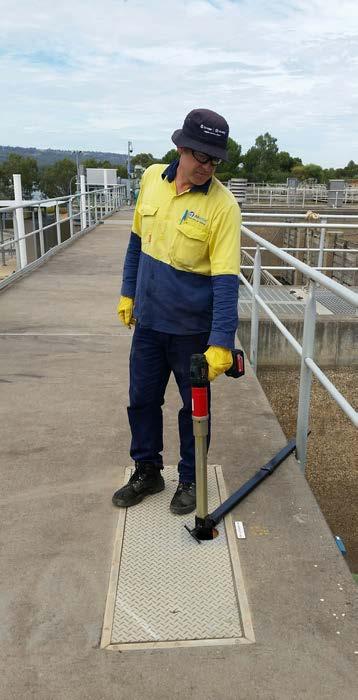
THE SOLUTION
Network technicians used this equipment to help reduce shut-off times when working on trunk mains that required a shut down for such occurrences as burst mains, or capital works programs for expansion and/or modification of the network.
Who helped work on the solution?
Network Technician Aaron Posad demonstrated the valve key opener and the advantages of the valve opener, coupled with the reduction in time to open the valves quickly became apparent.
Describe the solution.
The solution was to use an electrically operated valve key opener that incorporated a torque limiter to reduce the potential to break the valve if torque became excessive. Use of small battery packs enables the valve opener to open or close 2 valves in a short time when compared to manual operation.
A detachable reaction arm is used against a solid structure to prevent rotation of the valve opener when attached to the valve and to maximise safe operation of the valve key opener.
How has it helped you at work?
The time to operate the sedimentation inlet penstock valves has decreased considerably. One person, using the valve key opener and several battery packs, is able to open or close the inlets to a sedimentation tank safely and quickly with a huge decrease in the potential for injury.
Suggest improvements.
A long term fix would be to fit electric motors that were connected to the plant’s SCADA system to allow remote operation of the sedimentation inlet penstock valves.
This would allow remote operation during normal working hours or after hours operation by the on call duty operator via a lap top if required.
Electrically operated valve key opener
MEMSATCH 3000 - Membrane module saturator
Rod Morton, Water Treatment Plant Operator, Port Macquarie Hastings Council
THE PROBLEM
When performing pinning repairs to membrane modules at Telegraph Point WTP an entire rack of 32 modules needed to be removed from the filtration cell at the same time.
When the racks are removed from the cell they are placed on stands and the water in the membranes rapidly drains out. To identify the individual strands that require a pining repair, each module is placed into a test rig and low pressure air is applied. Only one module can be tested at a time.
The draining of the water from the membranes while on the racks allowed air to ingress into the membranes. This air ingress made it difficult to identify the individual strands that required a pinning repair as there was very little water left to create reasonable sized bubbles.
How did the problem impact you or your work situation?
When the membranes were placed in the test rig and low pressure air was applied the lack of water in the membranes caused false positives at the membrane ends.
This made it very difficult to identify the strands that required repair. We found that it was taking too long to complete our repairs. We were not sure if we were in fact pinning the correct strands and making effective repairs.
How long had the problem been occurring?
The problem had been occurring during all of our previous pinning repair attempts.
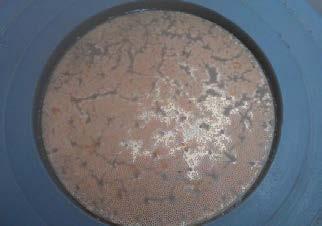
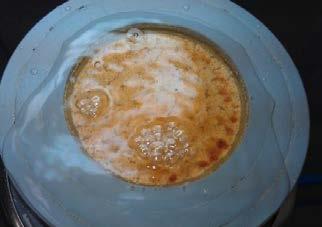
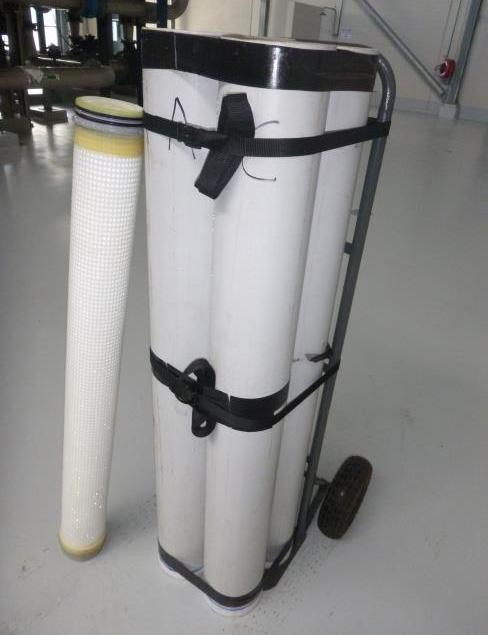
Membranes in test rig - false flow due to air ingress
Saturator Unit
THE SOLUTION
The individual strands requiring repair were easily identified in the first few membranes that were placed in the test rig. As we tested more membranes it became increasingly difficult to identify the repairs required. We considered that the water draining out of the membranes may be contributing to our problem. We realised that this draining was allowing air to ingress into the individual strands.
The membranes are hosed down while standing on the racks to keep them from drying out. We knew that the hosing down kept the membranes moist but did not saturate them. We decided that it would be easier to identify the leaking/broken strands if the membrane modules remained saturated.
We realised that AIR INGRESS was our problem and that SATUARATION was the solution. We decided we needed to saturate the membranes immediately prior to placing them in the test rig.
Who helped work on the solution?
Water Treatment Operators Rod Morton and Glenn Trimmer.
Describe the solution.
After realising that we needed to saturate the membranes prior to putting them in the test rig we first considered placing the racks back into the cell however this was not practical.
Next option was to build a saturator unit. So the ‘MEMSATCH3000’ was created. It is a simple tube type saturator device that was cheap to build, light weight and easy to use. The ‘MEMSATCH3000’ saturator consists of 4 x 150mm PVC tubes each 1300mm long. The bottoms of the PVC tubes are capped so they can hold water. The 4 tubes are bound together to form a four leaf clover the same as the configuration of the membrane clovers.
The membranes are removed from the racks one clover (4 membranes) at a time and placed into the saturator. The membranes are left in the saturator for a few minutes to saturate. They are then removed one at a time and placed immediately into the test rig and low pressure air applied. The strands requiring attention are easily identified and pinning repair is quickly completed. After repair, the membranes are placed back into the racks and another clover is removed for repair.
How has it helped you at work?
Our saturator has made our pinning repairs easier, less tedious, less time consuming and more effective.

Suggest improvements.
• Stainless steel pipes
• Valves to fill and drain
• Inlet valves to fill
• Tilt Trolley mount
This simple device took very little time to put together, was inexpensive and solved our problem so we could get on and do our repairs more efficiently and effectively.
Membrane being placed in saturator
Unbreakable water restrictor
Scott Petts, Operations Officer Wodonga Distribution, North East Water
THE PROBLEM
We have experienced some problematic customers that when they have restrictors put onto their meters, they either cut the lockable ones or drill out the brass inline ones, so they can have full access to water illegally without paying their water bills. These customers have been known to drill out or cut the restrictors as soon as a replacement one is fixed. This adds to a lot of Operator man hours replacing or repairing these restrictors. Also the customers at these properties are very argumentative to our staff and pose a safety risk to them as they repeatedly visited these properties.
How did the problem impact you or your work situation?
Visiting restricted customers numerous times to put in a new restrictor cost the business operator time, and money on replacing the restrictors and loss of water. It was also a safety concern sending staff to these premises on multiple occassions to re-restrict them.
How long had the problem been occurring?
Ever since water restrictors have been in place, some need replacing 4-5 times a month due to problematic customers that do not obey the enforced water restriction until they pay their water bills.
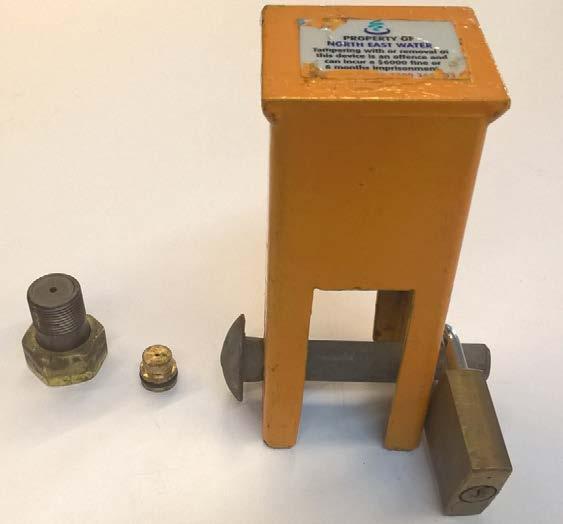
Newly designed high grade stainless steel water restrictor a lot larger and robust to the smaller original version that was drilled out and popped out repeatedly
Lockable water restrictors that are cut and tampered with
Original much smaller and weaker brass inline water restrictor
THE SOLUTION
After replacing many water restrictors and dealing with these customers I thought about designing a more robust inline water restrictor. That’s when I came up with the idea of designing an inline restrictor made out of high grade stainless steel.
Who helped work on the solution?
My work colleagues as well as the restriction officers worked to help me with this solution. I designed the new restrictor and sent it to a fabricator to make.
Describe the solution.
Instead of using brass inline water restrictors that can be easily drilled out or lockable water restrictors that can be easily cut, I have designed an inline water restrictor similar to the brass ones that I had fabricated out of high grade stainless steel to use at the residence of problematic customers. They are unable to drill through the high grade stainless steel and therefore unable to break through the restrictor repeatedly.
How has it helped you at work?
We have 10 of these newly designed restrictors in the reticulation and currently looking at having more made. The ones we have put into the reticulation have been a success, 4 of these customers have come to North East Water to see how they can pay their bills to have the restrictors removed. Since we have put these new restrictors in the residence of problematic customers, we have saved a lot of time by not repeatedly repairing and installing new restrictors only for them drilled out or cut within days. This has also reduced our safety concerns around visiting the properties of these argumentative customers weekly, cut operational costs on replacing the restrictors and paper work around replacing them.
Suggest improvements, if time or financial limitations were not a factor. Have more made so we have them available to use all the time on all customers not just the problematic ones. Have them made out of titanium so they are even more robust.
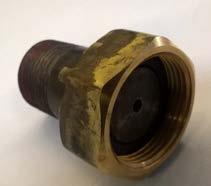
Inline water restrictor, made out of high grade stainless steel (small hole = restricted supply)
Customers water supply at a restricted rate

Water meter
Influent quarantine innovation at STP
James Castle, Treatment Plants Operations Manager, Unitywater
THE PROBLEM
Unitywater’s Burpengary East activated sludge Sewage Treatment Plant (STP), receives wastewater from domestic and industrial sources. Occasionally, substances in the influent temporarily affect process performance but don’t usually cause an environmental compliance issue. In 2013 the plant received an influent trade waste shock load which became apparent to operators when significant foaming was observed at the inlet works.
How did the problem impact you or your work situation?
Within an hour of the foam being observed, a spike in bioreactor aeration demand resulted in all blowers being called to run at 100%. This lasted for a number of hours, then air demand began to trend down. The site operators took this to mean that the process had been able to cope with the shock and things were on their way back to normal. During peak flow the following morning the operators became very concerned that there seemed to be no demand for air in the reactors and the final effluent quality was deteriorating so they alerted the treatment plants management team.
The spike in aeration demand the previous day, followed by what appeared to be the process returning to normal operation, was in fact the first few hours of the process biomass being killed. Some 25 tonnes of active living biomass were lost across the plant’s three parallel bioreactors. The entire biomass of the activated sludge STP process was dead. The incident was reported to the environmental regulator (the Department of Environment and Heritage Protection (DEHP)) in accordance with our reporting obligations.
At the peak of the incident we received significant interest from within our organisation, the media and DEHP. Operational actions taken in response to the incident ensured no ongoing adverse environmental impact. We were fortunate to receive excellent support from DEHP at the time.
How long had the problem been occurring?
The trade waste shock load has been a one-off event but the cost of incident response was significant, in the order of hundreds of thousands of dollars. The reseeding of the treatment process and intensive laboratory testing including catchment, process and environmental monitoring were the main expenditure items.
No repeat events have occurred since, but we do not want to be put in the same situation again.
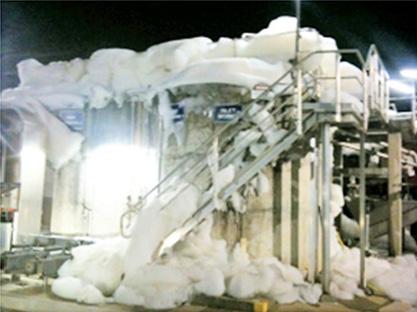
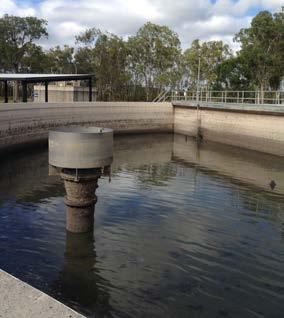
The raw sewage balance tank was central to the design of the solution.
THE SOLUTION
A lessons learnt exercise was conducted after the original incident: what we did well, what could be improved if we faced a similar situation again.
Who helped work on the solution?
Our solution was worked on by the operations incident response team.
Describe the solution.
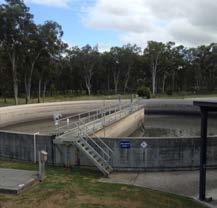
Unitywater chose to upgrade the plant with operations staff having a very high level of input into process design. Operators lobbied to ensure that the largest capacity possible Raw Sewage Balance Tank (RSBT) was included and a four ML RSBT was approved.
The operators were also adamant that flow from the RSBT to the bioreactors should be pumped due to concerns that using a conventional flow splitter would not allow accurate loading to the three parallel bioreactors. This request was also approved. The operators also wanted to maintain maximum process flexibility in the design to ensure that process units could be easily bypassed/taken out of service for inspection, cleaning and maintenance. The existing flow splitters were retained to enable flow to be diverted around the RSBT if necessary. An excellent and innovative trade waste shock response was created by:
• factoring in use of existing infrastructure to maximise operational flexibility, and
• pumping flow to the bioreactors, which gave the best control possible for process performance optimisation. At any sign of a toxic or inhibitory substance is arriving on site our first action is to immediately shut down the RSBT pumps. This ensures that any flow entering the plant is stored in the capacity available in the RSBT. The capacity of the trunk sewer between the industrial estate in the catchment and the inlet works of the STP has been calculated. After operators become aware of a potential problem with influent quality, one detention time of this sewerage rising main is allowed to elapse, with the volume being stored in the RSBT. The bioreactors do not receive any flow for this period.
After one detention time of the sewerage rising main has elapsed, operators open up a bypass valve that brings that original flow splitter flow path back into service and shut a valve that isolates flow from entering the RSBT. This effectively enables us to quarantine the suspect raw sewage. Samples are taken from the RSBT and sent away for analysis to determine if the raw sewage quality is satisfactory for processing through the bioreactors. In the interim, the process is fed raw sewage via the original flow split pathway without flow balancing. The plant has been operated this way on a number of occasions and performance is satisfactory although not quite as well controlled as when the RSBT is on line. After results are available, Unitywater process engineers calculate a flow rate so the contents of the RSBT can be bled back into the bioreactors.
Isolation valves currently need to be manually operated.

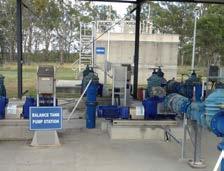
How has it helped you at work?
The process improvement allows more effective management of potential environmental and financial impacts. Increased automation is on our wish list. We would like automatic actuators fitted to the 750mm diameter valves that are currently manually operated each time we bypass flow to the flow splitters which enable the RSBT to be isolated.
Unitywater encourages operators to participate in any activities that have the ability to affect operations. Operators should always be given a sense of empowerment, ownership and responsibility. The value that engaged operators can add to a water utility should never be underestimated.
Raw sewage balance tank pump station in the foreground with flow splitter in the background.

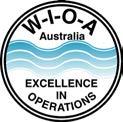
Award Objectives
• To create an opportunity which encourages water industry operational staff to share their in-the-field innovations and/ or fixes to problems so that others in the water industry can benefit.
• To provide an application process which is easy to complete and utilises a standard template. This will give all water industry operational staff the same opportunity for presenting their innovation.
• To provide the opportunity for operational staff to receive recognition for their innovation and efforts.
• To encourage operational staff to become aware of and involved with the Water Industry Operators Association of Australia (WIOA).
To allow WIOA to share the good ideas and innovations with other members through the Operator magazine and/or other publications.
The Process
The PASS application template and more details on the Award can be found on the WIOA web site or from the WIOA office.
Judging
All PASS applications received in the 12 month period ending 1st March annually, will be assessed by an independent panel on a number of criteria, including:
• Commonality of the problem
• Benefit to OH&S, water quality, and/or the environment
• Financial and sustainability benefits
• Application to other industries
• Uniqueness, adaptability and simplicity
Reward
The person who submits the PASS application deemed best in that particular year will be announced the winner of the PASS Award at the annual WIOA NSW Conference. Aqualift Project Delivery Pty Ltd, as the PASS Award sponsor, will provide sponsorship of $2,000 for the winner to join the WIOA team on their annual operational tour of New Zealand including attendance at the New Zealand
operations conference.
